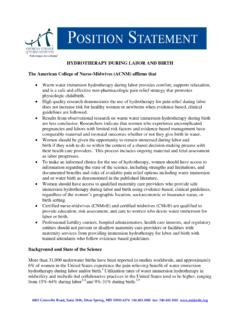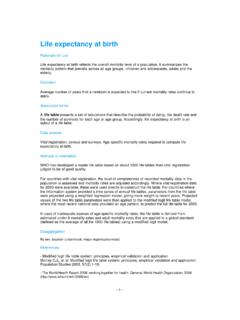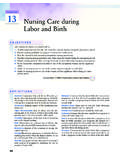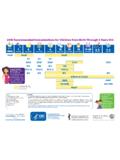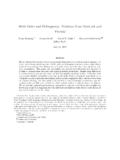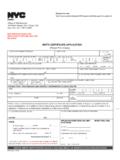Transcription of HYDROTHERAPY DURING LABOR AND BIRTH The American …
1 8403 Colesville Road, Suite 1550, Silver Spring, MD 20910-6374 fax: HYDROTHERAPY DURING LABOR AND BIRTH The American College of Nurse-Midwives (ACNM) affirms that Warm water immersion HYDROTHERAPY DURING LABOR provides comfort, supports relaxation, and is a safe and effective non-pharmacologic pain relief strategy that promotes physiologic childbirth. High quality research demonstrates the use of HYDROTHERAPY for pain relief DURING LABOR does not increase risk for healthy women or newborns when evidence-based, clinical guidelines are followed. Results from observational research on warm water immersion HYDROTHERAPY DURING BIRTH are less conclusive. Researchers indicate that women who experience uncomplicated pregnancies and labors with limited risk factors and evidence-based management have comparable maternal and neonatal outcomes whether or not they give BIRTH in water.
2 Women should be given the opportunity to remain immersed DURING LABOR and BIRTH if they wish to do so within the context of a shared decision-making process with their health care providers. This process includes ongoing maternal and fetal assessment as LABOR progresses. To make an informed choice for the use of HYDROTHERAPY , women should have access to information regarding the state of the science, including strengths and limitations, and documented benefits and risks of available pain relief options including water immersion and or water BIRTH as demonstrated in the published literature. Women should have access to qualified maternity care providers who provide safe immersion HYDROTHERAPY DURING LABOR and BIRTH using evidence-based, clinical guidelines, regardless of the women s geographic location, socioeconomic or insurance status, or BIRTH setting.
3 Certified nurse-midwives (CNMs ) and certified midwives (CMs ) are qualified to provide education, risk assessment, and care to women who desire water immersion for LABOR or BIRTH . Professional liability carriers, hospital administrators, health care insurers, and regulatory entities should not prevent or disallow maternity care providers or facilities with maternity services from providing immersion HYDROTHERAPY for LABOR and BIRTH with trained attendants who follow evidence-based guidelines. Background and State of the Science More than 31,000 underwater births have been reported in studies worldwide, and approximately 6% of women in the United States experience the pain relieving benefit of water immersion HYDROTHERAPY DURING LABOR and/or Utilization rates of water immersion HYDROTHERAPY in midwifery and midwife-led collaborative practices in the United States tend to be higher, ranging from 15%-64% DURING labor2-4 and 9%-31% DURING 8403 Colesville Road, Suite 1550, Silver Spring, MD 20910-6374 fax: The safety and efficacy of immersion HYDROTHERAPY are well established for the first stage of LABOR .
4 While pain relief is the only certain effect of immersion HYDROTHERAPY in LABOR at this time, immersion may also hasten cervical dilation, resolve LABOR dystocia, and contribute to postpartum maternal satisfaction with ,7 Regarding potential risks associated with HYDROTHERAPY DURING LABOR , no evidence demonstrates that immersion DURING the first stage of LABOR affects maternal intrapartum or postpartum infection, length of second or third stage LABOR , type of delivery, perineal laceration incidence or severity, postpartum blood loss, rate of hemorrhage, or postpartum Similarly, no relationship has been found between HYDROTHERAPY and abnormal fetal heart rate patterns, meconium stained amniotic fluid, umbilical cord blood pH values, newborn Apgar scores, infections, admissions to special care nurseries, or rate of breastfeeding at 6 weeks Most evidence about BIRTH in water has been gathered from clinical audits and observational studies rather than randomized controlled trials.
5 While additional research is needed regarding the effects of water immersion in the second and third stages of LABOR , there is a growing body of evidence available. Despite excellent neonatal outcomes observed in these studies of water birth4, 8-41 concerns about the limitations of prior study designs are heightened by case reports of various adverse neonatal outcomes that have been attributed to LABOR and/or BIRTH in While these concerns warrant follow up and future study, observational studies provide more reliable evidence versus case studies which should not be used as the basis for final practice recommendations. 64, 65 An additional consideration is the potential for intrapartum immersion to support physiologic BIRTH and cost containment in maternity care, primarily due to its efficacy as a non-pharmacologic method of pain Childbearing women in the United States typically experience multiple medical and obstetric interventions DURING LABOR and BIRTH that result in increased cost of maternity care and potential for iatrogenic complications as unintended For example, epidural analgesia presents a greater risk for operative vaginal delivery than other forms of pain relief in LABOR , and its use is often accompanied by interventions such as continuous fetal monitoring, administration of intravenous fluids, and bladder catheterization.
6 66 Evidence-Based Practice The use of HYDROTHERAPY DURING LABOR and BIRTH should be guided by evidence-based guidelines. To date, data on HYDROTHERAPY guidelines are limited, but researchers have suggested regulation of water temperature to degrees Celsius to prevent maternal and fetal hyperthermia and minimize the risk of premature respiration at the time of underwater DURING immersion HYDROTHERAPY , maternity care providers should monitor maternal temperature and vital signs and fetal well-being per individualized risk assessment. The infant s face should be brought to the surface immediately after underwater BIRTH without stimulation en route or subsequent re-immersion to avoid the unlikely event of water ,68-70 Attention to umbilical cord length to reduce tension DURING the process of bringing the infant to the surface, followed by immediate inspection of the umbilical cord and attachment site post BIRTH is Thermoregulation can usually be maintained by keeping the infant s body submerged with the 8403 Colesville Road, Suite 1550, Silver Spring, MD 20910-6374 fax: face above water.
7 Other standards of care DURING LABOR and BIRTH for mothers and their newborns remain the same regardless of the use of HYDROTHERAPY . Consistent with the use of obstetric emergency drills to assure quality care, scenarios involving HYDROTHERAPY should be included in sites where applicable. In summary, LABOR and BIRTH in water can be safely offered to women with uncomplicated pregnancies and should be made available by qualified maternity care providers. LABOR and BIRTH in water may be particularly useful for women who prefer physiological childbirth and wish to avoid use of pharmacological pain relief methods. REFERENCES 1. Nutter, E, Meyer S, Shaw-Battista J, Marowitz A. (in press). Waterbirth: An integrative analysis of peer reviewed literature. Journal of Midwifery & Women's Health 2.
8 CNM Data Group. Midwifery management of pain in LABOR . J Nurse Midwifery. 1998;43(2):77-82. 3. Cohen J. Integrating water into maternity care. Midwifery Today Childbirth ;Fall(39):36. 4. Rosenthal M. Warm-water immersion in LABOR and BIRTH . Female Patient. 1991;16: 44-50. 5. Church L. Water BIRTH : one birthing center's observations. J Nurse Midwifery. 1989;34(4):165-70. 6. Cluett E, Pickering R, Getliffe K, St. George-Saunders N. Randomised controlled trial of labouring in water compared with standard of augmentation for management of dystocia in first stage of labour. BMJ. 2004;328(7435): 314. 7. Cluett E, Burns E. Immersion in water in labour and BIRTH . Cochrane Database Syst Rev. 2009;2: CD000111. 8. Aird I, Luckas M, Buckett W, Bousfield P. Effects of intrapartum HYDROTHERAPY on labour related parameters.
9 Aust N Z J Obstet Gynaecol. 1997;37(2):137-42. 9. Alderice F, Renfrew M, Marchant S, et al. Labour and BIRTH in water in England and Wales. BMJ. 1995;310:837. 10. Baxter L. What a difference a pool makes: making choice a reality. Br J Midwifery. 2006;14(6):368-72. 11. Bodner K, Bodner-Adler B, Wierrani F, et al. Effects of water BIRTH on maternal and neonatal outcomes. Wien Klin Wochenschr. 2002;114(10-11):391-5. 12. Burke E, Kilfoyle A. A comparative study: waterbirth and bedbirth. Midwives. 1995;108:327. 13. Brown L. The tide has turned: audit of water BIRTH . Br J Midwifery. 1998;6(4):236-43. 14. Burns E, Boulton M, Cluett E, Cornelius V, Smith, L. Characteristics, interventions, and outcomes of women who used a birthing pool: a prospective observational study.
10 BIRTH . 2012; 39(3):192-202. 15. Chaichian S, Akhlaghi A, Rousta F, Safavi M. Experience of water BIRTH delivery in Iran. Arch Iran Med. 2009;12(5):468-71. 16. Otigbah CM, Dhanjal MK, Harmsworth G. Chard T. A retrospective comparison of water births and conventional vaginal deliveries. Eur J Obstet Gynecol Reprod Biol. 2000;91(1):15-20. 8403 Colesville Road, Suite 1550, Silver Spring, MD 20910-6374 fax: 17. Cortes E, Basra R, Kelleher CJ. Waterbirth and pelvic floor injury: a retrospective study and postal survey using ICIQ modular long form questionnaires. Eur J Obstet Gynecol Reprod ;155(1):27-30. 18. Dahlen, HG, Dowling, H, Tracy M, Schmied V, Tracy S. Maternal and perinatal outcomes amongst low risk women giving BIRTH in water compared to six BIRTH positions on land.
